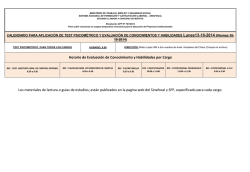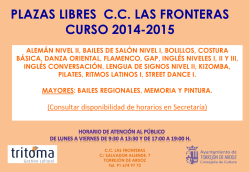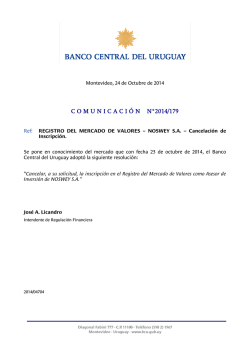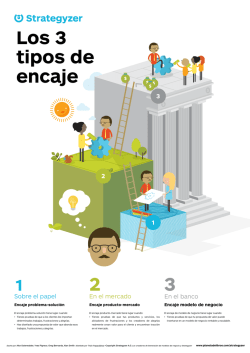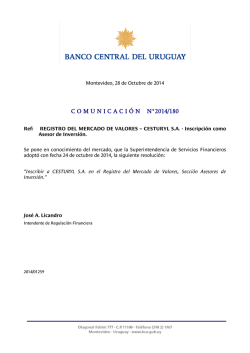
abanicos -fans
ABANICOS- FANS ~añol - English ARZO 2016 PASO a PASO montaje abanicos fan assembling S • Lace fans JB Bolilleras Special Fans ABANICOS-FANS Bolilleras Marzo 2016 – March 2016 HISTORIA / HISTORY 01 ENCAJE ARABESCO CORDOBES The arabesque cordobes lace PASO A PASO / STEP BY STEP 02 MONTAJE DE ABANICOS Fan assembling DISEÑOS / DESIGNS 03 Diseño portada/ Cover design © Mª Isabel Albert García DISEÑOS DE ABANICOS Designs fans lace Bolilleras Special Fans Marzo 2016 – March 2016 Directora: Maribel Albert Subdirector: Pablo Cocconi Colaboradores diseño textil: Hana Humlová, Priit Halberg, Marcela Susana Toledo Nespral. Redacción en Valencia: Poeta Miguel Hernández, 32; 46163 Valencia. Suscripción y ejemplares atrasados: 675198684 [email protected] (+34) BOLILLERAS MAGAZINE Valencia 2016. Tiene todos los derechos reservados. Esta publicación no puede, ni en todo ni en parte, ser distribuida, comunicada públicamente, reproducida por cualquier sistema, medio o forma, sin autorización previa y por escrito del editor. BOLILLERAS es una revista de edición trimestral, con 4 números al año. De edición Digital e impresa, que pueden ser adquiridos individualmente desde nuestra web. En varios idiomas: Español-Inglés. Nuestro objetivo es crear una revista DIDÁCTICA, SENCILLA e INNOVADORA al alcance de tod@s l@s Encajer@s, con dificultades de acceder al aprendizaje del Encaje de Bolillos Editorial in Valencia: Poeta Miguel Hernández, 32; 46163 Valencia - Spain. Subscriptions and back issues: (+34) 675198684 [email protected] BOLILLERAS MAGAZINE Valencia 2016. Has all rights reserved. This publication may not, in whole or in part, be distributed, publicly communicated, reproduced by any means, means or form without prior written permission of the editor. BOLILLERAS is a quarterly magazine edition, with 4 issues per year. Digital and print, which can be purchased individually from our website. In several languages: Spanish-English. Our goal is to create an educational, simple and innovative magazine available to all lacemakers with learning difficulties accessing the bobbin lace. © BOLILLERAS 2016 , editado en España Bolilleras ABANICOS-FANS Mª Isabel Albert García Senior Editor Queridos lectores, He aquí la primera edición anual de BOLILLERAS, una revista trimestral que ofrece una interpretación del encaje de bolillos basada en el Arte y el Diseño. La revista BOLILLERAS ha sido fundada para presentar una dimensión distinta del mundo del encaje de bolillos que hasta ahora ha sido mostrada. Es por eso que la revista BOLILLERAS intentará justificar que la realidad del encaje podría ser mejor comprendida por el estudio teórico-práctico e histórico del encaje de bolillos, fusionado con las nuevas tecnologías, el arte del diseño y la moda. Intentará aportar respuestas claras a las cuestiones del cómo y del porqué del encaje, que quedaron irresolutas o que suscitaron enfoques erróneos. BOLILLERAS, teniendo en cuenta lo dicho anteriormente, pretende ser una fuente de información verídica y confirmada para llenar los huecos en los conceptos del diseño y la enseñanza del encaje de bolillos. Difundirá en cada número diferentes estudios y pensamientos que serán analizados y contrastados con aportes documentativos tanto históricos como prácticos. Así la revista se compromete a tratar de concienciar y educar tratando tanto los temas históricos, teórico-prácticos, de diseño y actualidad del encaje de bolillos. Procurará introducir, interpretar y preservar los valores del encaje de bolillos con el fin de mejorar la percepción de este Arte. Mª Isabel Albert García © BOLILLERAS 2016 , editado en España Bolilleras Bolilleras Special Fans Bolilleras Special Fans This is the first annual edition of BOLILLERAS, a quarterly magazine that provides an interpretation of bobbin lace-based Art and Design. The magazine BOLILLERAS has been founded to present a different dimension in the world of bobbin lace which until now has been shown. That's why the magazine BOLILLERAS attempts to justify the reality of the lace could be better understood from the theoretical and practical and historical study of bobbin lace, merged with the new technologies, the art of design and fashion. Attempts to provide clear answers to the questions of how and why lace, which were unresolved or raised wrong approaches. BOLILLERAS, taking into account the above, intended as a source of accurate information and confirmed to fill the gaps in design concepts and teaching of bobbin lace. It spread in each issue different studies and thoughts that will be analyzed and compared with documentativos both historical and practical contributions. So the magazine is committed to try to raise awareness and educate trying both, theoretical and practical, design and current historical themes of bobbin lace. Endeavor to introduce, interpret and preserve the values of bobbin lace in order to improve the perception of this art. Mª Isabel Albert García © BOLILLERAS 2016 , editado en España Dear readers, ARABESCO CORDOBÉS 1 ENCAJE ARABESCO CORDOBÉS El encaje arabesco cordobés recrea los atauriques con resonancias del esplendor omeya. The Cordoba arabesque lace recreates atauriques with echoes of the Umayyad splendor. Bolilleras Special Fans [El ataurique hace referencia a un adorno de formas geométricas y patrones extravagantes que imita formas de hojas, flores, frutos, cintas, animales y aparece mucho en las paredes de ciertas construcciones árabes, como el Palacio de Medina Azahara o la Mezquita de CórdobaEspaña. Sin embargo es mucho más que esto]. El motivo de este articulo, es dar a conocer la investigación histórica que se ha obtenido de los tejidos hispanomusulmanes y afines, que cubren el periodo de la Córdoba Califal, la mayor parte de la información se ha obtenido en los Archivos del Instituto de Patrimonio Histórico Español y del Museo de Bellas Artes de Córdoba y de su adaptación al encaje de bolillos creando así el Encaje arabesco Cordobés. Con la llegada de los musulmanes a la Península Ibérica y su asentamiento en al-Andalus comienza la historia del tejido de seda, pues las primeras noticias de estas fabricaciones, así como la introducción de la sericultura la ofrecen los cronistas de la España musulmana. Mª Isabel Albert García. © 2016 Bolilleras © BOLILLERAS 2016 , editado en España Posiblemente con ‘ Add al-Rahman I (756-788), primer emir omeya, que estableció su corte en Córdoba y se rodeó de artistas sirios, debió empezar a florecer la manufactura de seda. Algunos de estos tejidos son fragmentos que en ocasiones pudieron ser utilizados, como productos de piezas regaladas por los musulmanes a los embajadores cristianos o como botín de guerra al reconquistar los reyes cristianos las zonas en poder musulmán. En ocasiones, se usaron en las iglesias como forros de arquetas de reliquias tan en boga en la Edad Media. Otros serían adquiridos en el mercado andalusí u otros mercados de lujo de la España cristiana. La mayoría de los tejidos formaron parte de indumentaria, tanto religiosa como civil aunque también se usaron como forros de ataúdes de pino, embelleciéndolos en la parte […] Bolilleras Special Fans [The ataurique refers to an ornament of geometric shapes and patterns that mimics bizarre shapes of leaves, flowers, fruits, ribbons, animals and appears on the walls of some Arab buildings like the Palace of Medina Azahara or the Mosque of Cordoba-Spain . However it’s much more than this]. The purpose of this article is to present the historical research that has been obtained from the Hispanomusulman and related tissues, which cover the period of the Cordoba Caliphate, most of the information has been obtained from the archives of the Institute of Historical Heritage Spanish and the Museum of Fine Arts of Cordoba and its adaptation to bobbin lace creating the Cordoba arabesque lace. With the arrival of the Muslims in the Iberian Peninsula and their settlement in al-Andalus begins the history of silk weaving, as the first news of these fabrications, and the introduction of sericulture is provided by the chroniclers of the Muslim Spain. Palacio de Medina Azahara (Córdoba – Spain) Some of these tissues are sometimes fragments could be used as replacement products donated by Muslims or Christians as spoils of war to reconquer the Christian kings areas to Muslim ambassadors. Sometimes they were used in churches as relics caskets lining so popular in the Middle Ages. Others would be purchased in the market or other markets Andalusian luxury of Christian Spain. Most were part of apparel fabrics, both religious and civil but also were used as liners pine coffins, embellishing in Part […] © BOLILLERAS 2016 , editado en España Possibly 'Add al-Rahman I (756-788), first Umayyad emir who established his court in Cordoba and was surrounded by Syrian artists, had to start manufacturing silk flower. Bolilleras Special Fans Por la abundancia de ejemplares, similares a estos que estudiamos, en los panteones reales y porque aparecen varios tejidos coetáneos con escudos, tanto de los reyes como de la nobleza, debemos pensar que se trataba de encargos textiles hechos ex profeso a los talleres andalusíes, posiblemente privados y dedicados al negocio textil. Debido a la gran producción textil que reflejan los historiadores, para abastecer a los numerosos talleres se puede pensar que, si el trabajo o el proceso del hilado era manual, se realizaría con la ayuda de algún sistema semimecánico que permitiera un molinaje múltiple y produjera unos hilos finos y regulares en su torsión (Saladrigas, 1996). Según la Enciclopedia del Islam, <<tiraz>> es una palabra de origen persa que significaba <<bordado>>. En principio se aplicó para designar mantos con elaborados bordados, especialmente un tipo de manto con bandas de escritura bordada para uso de personas regias o de clases sociales altas. Por extensión se llamó tiraz al taller o lugar donde se hacían tales tejidos que generalmente se establecían en los palacios reales y cuya producción era casi para uso exclusivo del monarca. Ibn Idharí habla de la existencia de talleres cordobeses donde se realizaban tejidos que llevaban bordado el nombre del emir ‘Adb Allah (888-912), manifestación de grandeza y poder. Estudio histórico artístico de los tejidos andalusíes y afines cordobeses. Por Cristina Partearroyo Lacaba […] inner and outer. Also pillows and cushions of different burials are preserve. By the abundance of fish, similar to those we studied, in the real pantheons and that several peers tissues they appear with shields, both kings and nobility, we think that was expressly made textile orders to the Andalusian workshops, possibly private and dedicated to textile business. Because of the large textile production reflecting historians, to supply the numerous workshops may think that if the work or the spinning process was manual, be carried out with the help of a semi-mechanical system that allows multiple *molinaje and produce a fine and regular yarns in twisting (Saladrigas, 1996). According to the Encyclopedia of Islam, <<tiraz >> it is a word of Persian origin which meant <<embroidery>>. In principle it was applied to designate robes with elaborate embroidery, especially a kind of cloak with embroidered bands writing for use of royal persons or upper classes. By extension tiraz he was called to the shop or place where such tissue is generally established in the royal palaces and the production was almost exclusively for the monarch became. Ibn Idhari speaks of the existence of Cordoba workshops where embroidered fabrics bearing the name of the emir 'Abd Allah (888-912), were held manifestation of greatness and power. art historical study of the Andalusian from Cordoba and related tissue. by Cristina Partearroyo Lacaba © BOLILLERAS 2016 , editado en España […] interior y exterior. Igualmente se conservan almohadones y cojines de los diferentes enterramientos. Montaje de abanicos – fan assembling 1 2 3 © BOLILLERAS 2016 , editado en España 2 Special Fans BY STEP PASOBolilleras A PASO / STEP © BOLILLERAS 2016 , editado en España Bolilleras Special Fans 4 5 6 © BOLILLERAS 2016 , editado en España Bolilleras Special Fans 7 8 9 Fans PLEGADOBolilleras ABANICO Special / FOLDING FAN Montaje de abanicos – fan assembling En la plantilla las dos líneas de los extremos corresponden a los bordes del encaje. Cada línea marca los pliegues que siempre son el doble más dos del número de varillas. Cortamos la tela un poco más grande que el tamaño del abanico y colocamos sobre ella la plantilla para empezar a calcar las líneas. Debemos fijarla bien con el papel bien con agujas o adhesivo para que quede bien fija. Una vez que están bien marcadas las líneas, quitamos la plantilla y recortamos la tela dejando visibles las marcas. Colocamos nuestro encaje sobre la tela, teniendo bien cuidado en dos cosas: que el encaje no toque la parte en donde están las marcas a lápiz, ya que se podría manchar y que el encaje quede muy bien centrado entre las marcas que hemos dibujado con los extremos del encaje pegados a las líneas de corte. Ahora viene el momento de coger una plancha y ponerla a calor medio. No planchéis el encaje directamente, cubrirlo con una tela de hilo a ser posible. El primer pliegue lo marca el primer hilván de la izquierda. Siempre se hace hacia dentro. Si tienes dudas mira un abanico que tengas a mano y compruébalo. Haz el pliegue siguiendo la línea del hilván y, con mucho cuidado, márcalo con la plancha. ¡NO MUY CALIENTE! El pliegue tiene que quedar muy marcado. Ahora tenemos que hacer el segundo pliegue hacia fuera y así sucesivamente hasta que quede con forma de acordeón. Pliega bien fuerte todo el abanico, sujétalo con alfileres “encarados” para que quede muy bien cerrado y fuerte. Lo guardas bien y no lo despliegues hasta pasados unos cuantos días como una semana. For starters need: Template with brands fold lines, cloth-like "remair" or any non adhesive fine interlining, ruler, pencil and scissors. In the template the two lines of the ends correspond to the edges of the lace. Each line marking the folds that are always twice the number plus two rods. We cut slightly larger than the size of the fan and put on it the template to start tracing the lines fabric. We must fix it well with the role well with needles or adhesive to secure it fixed. Once the lines are well marked, we remove the template and cut fabric leaving visible marks. We put our lace on the fabric, taking good care of two things: that the lace do not touch the part where are the pencil marks as they could stain and lace remains well centered between the brands that have drawn the glued ends of the lace trim lines. Now comes the time to take a griddle and place over medium heat. Do not iron directly lace, cover it with a linen cloth if possible. The first fold marks the first basting on the left. Always it has done inward. When in doubt look at a fan that you have at hand and see. Make the fold along the lines of basting and, very carefully, mark it with the ironing. NOT SO HOT! The fold has to be very strong. Now we have to fold out the second and so on until with accordion. Fold up very strong full range, fastened with pins "faced" so that it is well sealed and strong. You keep well and do not deployment until after a few days a week. © BOLILLERAS 2016 , editado en España Para empezar necesitas: Plantilla con las marcas de las líneas de plegado, tela tipo “remair” o cualquier tipo de entretela fina no adhesiva, regla, lápiz y tijeras. © BOLILLERAS 2016 , editado en España PLANTILLA PARA 14 VARILLAS / TEMPLATE TO 14 RODS Bolilleras Special Fans AMOLIAR /SCALE 200% R-1 ANEXO © Hana Humlová 3 Bolilleras Special Fans DISEÑO ABANICOS /DESING FANS Pais 16:00 cm; Varillas 10:00 cm Ref.- 78-B Natural Pais Varillas Ref.- 78-B Blanco Ref.- 78-B Negro Pais Varillas [email protected] 0034 627 507 909 www. laboutiquedelabanico.com © Hana Humlová Bolilleras Special Fans DMC cebelia grosor 30, 100% algodón (carta colores) Colores: Rojo ref. 666; Naranja ref. 946; Negro ref.310 © BOLILLERAS 2016 , editado en España DMC cebelia thickness 30, 100% cotton (color card) Colors: Red ref. 666; Orange ref. 946; Black ref.310 Hojas extremos negro 5 pares (10 bolillos) color negro 4 pares (8 bolillos) color rojo Flor central 7 pares (14 bolillos) color negro 2 pares (4 bolillos) color rojo Hojas extremos rojo 2 pares (4 bolillos) color rojo 2 pares (4 bolillos) color negro Malla 2 pares (bolillos) color negro, naranja Extreme black leaves 5 pairs (10 bobbins) color black 4 pairs (8 bobbins) color red central flower 7 pairs (14 bobbins) color black 2 pairs (4 bobbins) color red Extreme red leaves 2 pairs (4 bobbins) color red 2 pairs (4 bobbins) color black Net 2 pairs (bobbins) color black, orange 24 pares TOTAL 24 pairs TOTAL R-2 ANEXO © Pablo Gustavo Cocconi 4 DISEÑO ABANICOS /DESING FANS Pais 16:00 cm; Varillas 09:00 cm Pais Varillas Ref.- 80-B Natural Ref.- 80-B Blanco Ref.- 80-B Negro Pais Varillas [email protected] 0034 627 507 909 www. laboutiquedelabanico.com Bolilleras Special Fans DMC Cordonnet spécial, grosor 100, (carta colores) Colores: Rosa oscuro ref. 899; Rosa ref. 604; Rosa claro ref.818 © BOLILLERAS 2016 , editado en España DMC Cordonnet spécial, grosor 100 (color card) Colors: Dark pink ref. 899; Pink ref. 604; Light pink ref.818 Flores 8 pares (16 bolillos) color 3 rosas Hojas 10 pares (20 bolillos) color 3 rosas Punto torchon 6 pares (12 bolillos) color rosa Punto lienzo 2 pares (4 bolillos) color rosa Flowers 8 pairs (16 bobbins) color 3 pinks Leaves 10 pairs (20 bobbins) color 3 pinks Torchon stitch 6 pairs (12 bobbins) color pink Cloth stitch 2 pairs (4 bobbins) color pink 26 pares TOTAL 26 pairs TOTAL Puntos usados: Trenza, hojas de guipur, torchón , lienzo Stitches: Plait, leaf tally, torchón, cloth stich R-3 ANEXO © Mª Isabel Albert García 5 DISEÑO ABANICOS /DESING FANS Pais 16:00 cm; Varillas 10:00 cm Ref.- 78-B Natural Pais Varillas Ref.- 78-B Blanco Ref.- 78-B Negro Pais Varillas [email protected] 0034 627 507 909 www. laboutiquedelabanico.com © Mª Isabel Albert García Bolilleras Special Fans DMC Mouliné Satin, (carta colores) Colores: Rojo ref. S321; Blanco S5200, Negro S310 © BOLILLERAS 2016 , editado en España DMC Mouliné Satin, (color card) Colors: Red ref. S321; White S5200, Black S310 2 pares 1 par 6 pares 1 par (4 bolillos) color blanco (2 bolillos) color negro (12 bolillos) color rojo para el guía color rojo 2 pairs (4 bobbins) white color 1 pair (2 bobbins) black color 6 pairs (12 bobbins) red color 1 pair weaver worker red color 12 pares TOTAL 12 pairs TOTAL Puntos usados: Punto cadena Stitches: Chain stitch
© Copyright 2026

